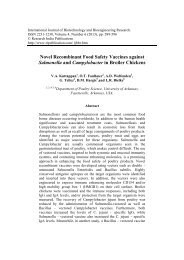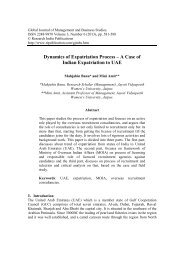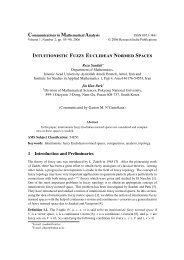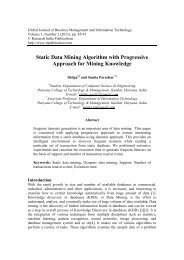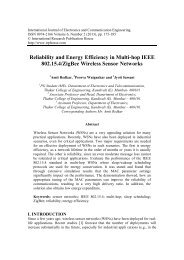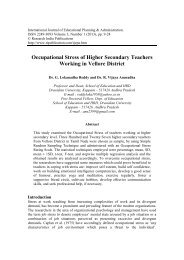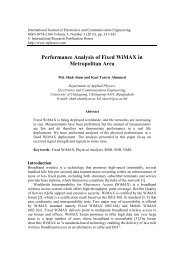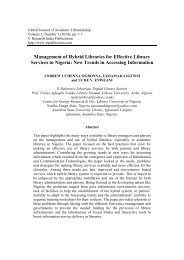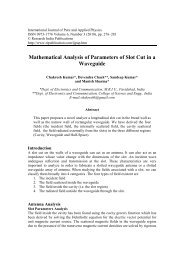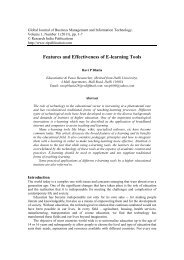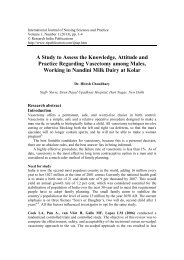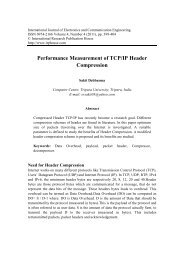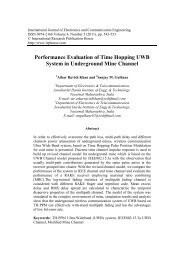Hedging of Currency Option in Trading Market - Research India ...
Hedging of Currency Option in Trading Market - Research India ...
Hedging of Currency Option in Trading Market - Research India ...
Create successful ePaper yourself
Turn your PDF publications into a flip-book with our unique Google optimized e-Paper software.
International Journal <strong>of</strong> Economic and Management Strategy.<br />
ISSN 2278-3636 Volume 3, Number 1 (2013), pp. 1-6<br />
© <strong>Research</strong> <strong>India</strong> Publications<br />
http://www.ripublication.com/jems.htm<br />
<strong>Hedg<strong>in</strong>g</strong> <strong>of</strong> <strong>Currency</strong> <strong>Option</strong> <strong>in</strong> Trad<strong>in</strong>g <strong>Market</strong><br />
1 Nandita Aggarwal, 2 Nit<strong>in</strong> Aggarwal , 3 Dr. Arv<strong>in</strong>d Dewangan<br />
and 4 Gaurav Aggarwal<br />
1 M.B.A. (F<strong>in</strong>ance), Panchkula, Haryana, <strong>India</strong>.<br />
E-mail- nit<strong>in</strong>424@gmail.com<br />
2 Assistant Eng<strong>in</strong>eer, Haryana Vidyut Prasaran Nigam Limited (HVPNL),<br />
Panchkula, Haryana, <strong>India</strong>.<br />
3 Associate Pr<strong>of</strong>essor, Civil Engg. Deptt.,<br />
Haryana College <strong>of</strong> Technology and Management,<br />
Kaithal, Haryana, <strong>India</strong>.<br />
4 B. Tech Student, Electrical & Electronics Engg.,<br />
Haryana College <strong>of</strong> Technology & Management,<br />
Kaithal, Haryana, <strong>India</strong><br />
ABSTRACT<br />
A currency option is a contract written by a seller that conveys to the<br />
buyer the right but not the obligation to buy (<strong>in</strong> the case <strong>of</strong> a call<br />
option) or to sell (<strong>in</strong> the case <strong>of</strong> a put option) a particular currency. In<br />
return for grant<strong>in</strong>g the option, the seller collects a payment (the<br />
premium) from the buyer. Two types <strong>of</strong> options are there: call option<br />
and put option.<br />
<strong>Currency</strong> trad<strong>in</strong>g can be extremely reward<strong>in</strong>g when we use hedg<strong>in</strong>g.<br />
<strong>Hedg<strong>in</strong>g</strong> provide a <strong>in</strong>vestor with a unique opportunity to ga<strong>in</strong> a high<br />
pr<strong>of</strong>it percentage. Trader purchase a ‘Call option’ if the currency is <strong>in</strong><br />
rise or ’Put option’ if the value is fall down us<strong>in</strong>g this pric<strong>in</strong>g model.<br />
If <strong>in</strong>vestor evaluate accurate trend <strong>of</strong> currency then pr<strong>of</strong>it marg<strong>in</strong> will<br />
be high. The ma<strong>in</strong> object <strong>of</strong> this paper is to f<strong>in</strong>d out optimized results<br />
us<strong>in</strong>g hedg<strong>in</strong>g for the <strong>in</strong>vestors to get maximum pr<strong>of</strong>it.<br />
Keywords: 1.<strong>Currency</strong> <strong>Option</strong> 2.Call option 3. Put <strong>Option</strong> 4. <strong>Hedg<strong>in</strong>g</strong><br />
5. Cross <strong>Hedg<strong>in</strong>g</strong><br />
Sub area: <strong>Currency</strong> option, <strong>Hedg<strong>in</strong>g</strong> <strong>in</strong> F<strong>in</strong>ancial management.<br />
Broad Area: Management
2 Nandita Aggarwal et al<br />
INTRODUCTION<br />
An option gives the right to buy or sell a particular asset, such as a piece <strong>of</strong><br />
property, or shares <strong>of</strong> stock or some other underly<strong>in</strong>g security, such as, among<br />
others, a futures contract. In return for grant<strong>in</strong>g the option, the seller collects a<br />
payment (the premium) from the buyer.<br />
Buy<strong>in</strong>g a call option provides the right to buy a specified quantity <strong>of</strong> a<br />
security at a set strike price at some time on or before expiration, while<br />
buy<strong>in</strong>g a put option provides the right to sell. Upon the option holder's choice<br />
to exercise the option, the party who sold, or wrote, the option must fulfill the<br />
terms <strong>of</strong> the contract.<br />
Exchange-traded options form an important class <strong>of</strong> options which have<br />
standardized contract features and trade on public exchanges, facilitat<strong>in</strong>g trad<strong>in</strong>g<br />
among <strong>in</strong>dependent parties. Over-the-counter options are traded between private<br />
parties, <strong>of</strong>ten well-capitalized <strong>in</strong>stitutions that have negotiated separate trad<strong>in</strong>g<br />
and clear<strong>in</strong>g arrangements with each other.<br />
Intr<strong>in</strong>sic value and time value<br />
The <strong>in</strong>tr<strong>in</strong>sic value (or "monetary value") <strong>of</strong> an option is the value <strong>of</strong><br />
exercis<strong>in</strong>g it now. Thus if the current (spot) price <strong>of</strong> the underly<strong>in</strong>g security is<br />
above the agreed (strike) price, a call has positive <strong>in</strong>tr<strong>in</strong>sic value (and is called<br />
"<strong>in</strong> the money"), while a put has zero <strong>in</strong>tr<strong>in</strong>sic value.<br />
The time value <strong>of</strong> an option is a function <strong>of</strong> the value less the <strong>in</strong>tr<strong>in</strong>sic<br />
value. It equates to uncerta<strong>in</strong>ty <strong>in</strong> the form <strong>of</strong> <strong>in</strong>vestor hope. It is also viewed<br />
as the value <strong>of</strong> not exercis<strong>in</strong>g the option immediately. In the case <strong>of</strong> a<br />
European option, you cannot choose to exercise it at any time, so the time<br />
value can be negative; for an American option if the time value is ever<br />
negative, you exercise it: this yields a boundary condition.<br />
ATM: At-the-money<br />
An option is at-the-money if the strike price is the same as the spot price <strong>of</strong><br />
the underly<strong>in</strong>g security on which the option is written. An at-the-money option<br />
has no <strong>in</strong>tr<strong>in</strong>sic value, only time value.<br />
ITM: In-the-money<br />
An <strong>in</strong>-the money option has <strong>in</strong>tr<strong>in</strong>sic value. A call option is <strong>in</strong>-the-money<br />
when the spot price is above the strike price <strong>of</strong> underly<strong>in</strong>g security. A put<br />
option is <strong>in</strong>-the-money when the spot price is below the strike price.<br />
OTM: Out-<strong>of</strong>-the-money<br />
An out-<strong>of</strong>-the-money option has no <strong>in</strong>tr<strong>in</strong>sic value. A call option is out-<strong>of</strong>-the-
<strong>Hedg<strong>in</strong>g</strong> <strong>of</strong> <strong>Currency</strong> <strong>Option</strong> <strong>in</strong> Trad<strong>in</strong>g <strong>Market</strong> 3<br />
money when the strike price is above the spot price <strong>of</strong> the underly<strong>in</strong>g security.<br />
A put option is out-<strong>of</strong>-the-money when the strike price is below the spot<br />
price.<br />
Long call<br />
A trader who believes that a stock's price will <strong>in</strong>crease might buy the right to<br />
purchase the stock (a call option) rather than just buy the stock. He would<br />
have no obligation to buy the stock, only the right to do so until the<br />
expiration date. If the stock price at expiration is above the exercise price by<br />
more than the premium (price) paid, he will pr<strong>of</strong>it. If the stock price at<br />
expiration is lower than the exercise price, he will let the call contract expire<br />
worthless, and only lose the amount <strong>of</strong> the premium.<br />
Long put<br />
A trader who believes that a stock's price will decrease can buy the right to<br />
sell the stock at a fixed price (a put option). He will be under no obligation<br />
to sell the stock, but has the right to do so until the expiration date. If the<br />
stock price at expiration is below the exercise price by more than the premium<br />
paid, he will pr<strong>of</strong>it. If the stock price at expiration is above the exercise price,<br />
he will let the put contract expire worthless and only lose the premium paid.<br />
Short call<br />
A trader who believes that a stock price will decrease, can sell the stock short<br />
or <strong>in</strong>stead sell, or "write," a call. The trader sell<strong>in</strong>g a call has an obligation to<br />
sell the stock to the call buyer at the buyer's option. If the stock price<br />
decreases, the short call position will make a pr<strong>of</strong>it <strong>in</strong> the amount <strong>of</strong> the<br />
premium. If the stock price <strong>in</strong>creases over the exercise price by more than the<br />
amount <strong>of</strong> the premium, the short will lose money, with the potential loss<br />
unlimited.<br />
Short put<br />
A trader who believes that a stock price will <strong>in</strong>crease can buy the stock or<br />
<strong>in</strong>stead sell a put. The trader sell<strong>in</strong>g a put has an obligation to buy the stock<br />
from the put buyer at the put buyer's option. If the stock price at expiration is<br />
above the exercise price, the short put position will make a pr<strong>of</strong>it <strong>in</strong> the<br />
amount <strong>of</strong> the premium. If the stock price at expiration is below the exercise<br />
price by more than the amount <strong>of</strong> the premium, the trader will lose money,<br />
with the potential loss be<strong>in</strong>g up to the full value <strong>of</strong> the stock.
4 Nandita Aggarwal et al<br />
<strong>Hedg<strong>in</strong>g</strong> <strong>in</strong> currency option trad<strong>in</strong>g<br />
<strong>Hedg<strong>in</strong>g</strong> means reduc<strong>in</strong>g or controll<strong>in</strong>g risk. <strong>Hedg<strong>in</strong>g</strong> is a two-step process. A<br />
ga<strong>in</strong> or loss <strong>in</strong> the cash position due to changes <strong>in</strong> price levels will be<br />
countered by changes <strong>in</strong> the value <strong>of</strong> a futures position.<br />
Example<br />
In the simplest form, an <strong>India</strong>n trader buys some goods from USA and after<br />
three months he pays $10,000 to USA trader. Mr. A th<strong>in</strong>k, In future $ price<br />
will be more than today price. So, he buys a call option for $10,000 at the<br />
strike price <strong>in</strong> Rs.54.80/$ and pay premium 0.05. He buys this contract for<br />
three months. After three months, if spot rate is Rs. 55.10/$ then Mr. A<br />
mature this contract because contract price is less than the spot price. It is<br />
pr<strong>of</strong>itable for A. If the spot price is Rs. 54.70/$ is less than the contract price<br />
then Mr. A will not mature that contract because he had a call option. If both<br />
price is same means spot price is equal to strike price plus premium then it’s<br />
a break-even po<strong>in</strong>t i.e. no pr<strong>of</strong>it or no loss. Then Mr. A completes this<br />
contract.<br />
<strong>Option</strong> style- In this paper, European option has used that may only be<br />
exercised on expiration.<br />
Cross <strong>Hedg<strong>in</strong>g</strong><br />
Cross hedg<strong>in</strong>g is also very helpful <strong>in</strong> currency option trad<strong>in</strong>g because when a<br />
particular currency is not available <strong>in</strong> the market then a trader buy a another<br />
currency, call or put option that positively co-related with needed currency. If<br />
required currency value is appreciated then that currency value will also<br />
appreciate.<br />
Although the two currency are not identical, they are correlated enough to<br />
create a hedged position as long as the prices move <strong>in</strong> the same direction.<br />
This paper shows correlation between US dollar and Australian dollar<br />
(AUD). For this correlation, data <strong>of</strong> 15 October 2012 to 19 October 2012 have<br />
been taken for analysis.<br />
US Dollar rate is denoted ------- X<br />
AUD rate is denoted -------- Y<br />
Date Us dollar dx dx 2 AUD rate dy dy 2 dxdy<br />
Rate ( x)<br />
( y)<br />
15.10.2012 53.09 0.23 0.0529 54.31325 -0.3432 0.1178 -0.0789<br />
16.10.2012 52.89 0.03 0.0009 54.32522 -0.3312 0.1097 -0.0099<br />
17.10.2012 52.86 0.0 0.0 54.65642 0.0 0.0 0.0<br />
18.10.2012 53.46 0.6 0.36 55.45203 0.7956 0.6330 0.4774<br />
19.10.2012 54.08 1.22 1.4884 55.76037 1.1040 1.2188 1.3469<br />
∑dx = 2.08 ∑dx 2 = ∑dy = ∑dy 2 = ∑dxdy =<br />
1.9022 1.2252 2.0793 1.7355
<strong>Hedg<strong>in</strong>g</strong> <strong>of</strong> <strong>Currency</strong> <strong>Option</strong> <strong>in</strong> Trad<strong>in</strong>g <strong>Market</strong> 5<br />
dx = X – 52.86<br />
dy = Y – 54.65642<br />
N = 5<br />
r = 0.9<br />
Where x and y are two variables under consideration. The value <strong>of</strong><br />
coefficient <strong>of</strong> correlation obta<strong>in</strong>ed shall lie between +1 to -1. When r=+1 then<br />
there is perfect positive correlation between the variables. When r =-1 then<br />
there is perfect negative correlation between the variables. When r =0 then<br />
there is no relationship. In US Dollar and AUD coefficient <strong>of</strong> correlation is<br />
o.9 then positive high degree <strong>of</strong> correlation.<br />
CONCLUSIONS<br />
HEDGING is technique designed to reduce or elim<strong>in</strong>ate f<strong>in</strong>ancial risk. <strong>Hedg<strong>in</strong>g</strong><br />
is the calculated <strong>in</strong>stallation <strong>of</strong> protection and <strong>in</strong>surance <strong>in</strong>to a portfolio <strong>in</strong><br />
order to <strong>of</strong>fset any unfavorable moves. Cross hedg<strong>in</strong>g is also useful <strong>in</strong> option<br />
trad<strong>in</strong>g market. Us<strong>in</strong>g this technique, some suitable results are f<strong>in</strong>d out, when<br />
a trader need a particular currency for hedg<strong>in</strong>g but <strong>in</strong> the market that currency<br />
is not available then trader use cross hedg<strong>in</strong>g means they can use another<br />
currency that is positive correlated with required currency. And on buy<strong>in</strong>g that<br />
currency it reduces risk.<br />
References<br />
[1] Marc Chesney and Louis Scott” Pric<strong>in</strong>g European currency options: A<br />
comparison <strong>of</strong> the modified black-Scholes and a random variance<br />
Modelby” Journal <strong>of</strong> F<strong>in</strong>ancial and Quantitative Analysis, Vol24, No.3<br />
September 1989.<br />
[2] Peter carra, Liuren Wu,”Stochastic Skew <strong>in</strong> <strong>Currency</strong> <strong>Option</strong>s”<br />
[3] Habib Mahama, Chen Yu M<strong>in</strong>g, “<strong>Currency</strong> options trad<strong>in</strong>g practices and<br />
the construction and governance <strong>of</strong> operational risk: A case study”<br />
Account<strong>in</strong>g, Audit<strong>in</strong>g & Accountability Journal, Vol. 22 Iss: 4, pp.626 –<br />
660<br />
[4] G. Coenen and A. T. Lev<strong>in</strong>, “Identify<strong>in</strong>g the <strong>in</strong>fluences <strong>of</strong> nom<strong>in</strong>al and<br />
real rigidities <strong>in</strong> aggregate price-sett<strong>in</strong>g behavior” November 2004.<br />
[5] Vyuptakesh Sharan:’International F<strong>in</strong>ancial Management, Prentice Hall <strong>of</strong><br />
<strong>India</strong>, New Delhi.
6 Nandita Aggarwal et al<br />
[6] Alok Pandey: Mult<strong>in</strong>ational Bus<strong>in</strong>ess F<strong>in</strong>ance, Pearson Education.<br />
[7] Shapiro: Mult<strong>in</strong>ational F<strong>in</strong>ancial Management, Prentice Hall <strong>of</strong> <strong>India</strong>,<br />
New. Delhi.



